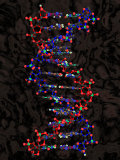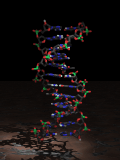

"We used to think that our fate was in our stars, but now we know that, in large measure, our fate is in our genes, "quotes James Watson. This fate that Watson is talking about is contained in our genes, and deals with a new technique, gene therapy. Gene therapy is revolutionizing the world of medicine. Many physicians are predicting that in twenty years gene therapy may change the practice of medicine from a treatment-based to a prevention-based practice. Our future is l ocked away inside of our genes. Gene therapy is unlocking these doors. Researchers are starting to move away from developing new drugs, and towards finding an ultimate solution. That solution is to use gene therapy as a treatment for many genetic diseas es. Researchers hope that in the coming years, every genetic disease will have gene therapy as its treatment. Gene therapy could be the last therapy that the human race will ever need.
So what is this mystical new wonder called gene therapy? Gene therapy is the introduction of genes into existing cells to prevent or cure a wide range of diseases. For example, suppose a brain tumor is forming by
rapidly dividing cancer cells. The reason this tumor is forming is due to some defective or mutated gene. The therapy chosen for this case would be to use a herpes virus that has had its virulence removed, rendering it harmless. The virus is still abl
e to insert its genetic material into the target cells. The virus is then taken and injected into mouse cells, where it makes additional copies of itself. These mouse cells, now containing the virus, are then injected into the brain containing the tumor
. Once inside the brain, the virus seeks out the target tumor cells and invades them. The tumor will now start to produce herpes enzymes because the virus has inserted its genetic material into the tumor cells. Now a physician can treat the patient wit
h a herpes curing drug that will destroy the tumor cells along with the mouse cells that are producing the herpes enzyme. The other target of some of the various retroviruses used include: bone marrow, skin, and liver cells. Genetic alteration of bone
marrow cells aims to correct the mutated part of the cell or its progeny. Skin cells work in a different manner. Geneticists found that these cells synthesize and secrete proteins, but these are then transported through the blood to be utilized by other
cells. Researchers are trying to use skin cells to synthesize an enzyme that it does not normally make. They then hope that it will take that enzyme to some other cell. That cell may not be able to make that enzyme, but the skin cell transports an ess
ential enzyme that will help that new cell function properly. Research with liver cells is still in the beginning stages.
Keys to the Kingdom, Time Magazine
This new therapy appears to work quite well in the lab setting, or theoretically in some scientist's mind, but it still had not been proven in a human subject. The first human to receive gene therapy treatment wa
s a 4 year old girl with severe immune-deficiency disease. This disease is caused by a faulty gene that fails to produce a vital enzyme. In the therapy procedure, they extracted some of the girl's white blood cells. Then, they exposed them to a geneti
cally engineered virus that had lost its virulence but still carried normal versions of the gene that was not functioning correctly in the girl. The virus invaded the white blood cells, and then these cells were transfused back into the girl. Once back i
nside the girl's bloodstream, the cells began producing the proper enzyme. Although the girl still needs follow-up treatments, she now leads a relatively normal life following the gene therapy. This is one of the success stories of gene therapy.
With the success of this first gene therapy treatment, the public's expectations began to rise. They assumed that permanent cures would be achieved for many diseases. The problem with this over assumption is t
hat along with this miracle technique comes a host of technological problems. The main problem that geneticists are encountering is the viruses may target the wrong cells. These viruses often do not seek out the target cells, and sometimes they insert t
hemselves into the wrong place in the DNA. The area that the virus targets may trigger uncontrollable growth. This may lead to the development of a tumor, or a preexisting tumor may become larger due to either a mutated virus or insertion in the wrong p
lace. This would be a huge disadvantage if the virus was inserted into a cancer cell, and instead of inserting its DNA into the cell, it causes uncontrollable growth of the tumor. They have also found that even if the virus invades the target cell and i
nserts the new gene, sometimes that new gene fails to express itself. For example, a virus used in cystic fibrosis produced an inflammatory response. These is an example of the virus not producing the desired response. The trials with that virus had to
than be halted, and other virus vectors had to be developed. Another problem researchers are encountering, is delivering the viruses into bone-marrow stem cells. These cells divide infrequently, and the viruses used in gene therapy only insert genes in
to cells that are dividing. Despite some of these technological obstacles, researchers are still very optimistic for the future of gene therapy. In order for gene therapy treatment to succeed, scientists must be willing and able to overcome the many tec
hnological obstacles and hurdles that they are encountering in their research.
The other problem that researchers are encountering is in the research itself. Many skeptics say that not enough is known about this procedure, and so it should be confined to lab animals until more is k
nown. The researchers do not believe in this because human patients are vital to their research. The researchers need the public to understand that this technique is a new idea, and it will take time to work out all the details. The potential of the th
erapy appears to be limitless if the researchers are allowed to perform their lab work.
The basis of gene therapy is find a gene that is not functioning right and to insert a healthy portion into that gene. To find these genes, scientists must perform genetic tests or genetic screening to see i
f the gene that causes for example, cystic fibrosis, is present. This genetic testing is producing much controversy and raising many ethical and legal problems. Many believe that this is an invasion of privacy. They believe that if prenatal tests are
performed that these could lead to an increase in the number of abortions. Many people that hear a positive test for a disease are now are faced with a dilemma. That dilemma is in finding adequate insurance to cover the treatments, which could be gene t
herapy, or living out their lives knowing that they carry a gene for a disease. This positive test has placed them in a high risk group that they may have not been in if they had not been tested. This high risk tag makes insurance coverage almost imposs
ible to find. The insurance that will cover them may be extremely expensive. So, choosing to have the test may be a question of whether they think their current insurance will cover them or not. Many young couples may find out that they are carriers of
a disease, and now must decide if they want to have a child that could be born with a genetic disease. Still another problem is regulation of the uses of gene therapy. Our society is obsessed with the idea of youth and beauty. If scientists could ide
ntify the gene that contributes to youth or beauty, then the technique of gene therapy could be monopolized by the cosmetic industry to enhance beauty or to "turn back the clock." The problem with this is whether baldness, height, or beauty should be eno
ugh of a reason to require gene therapy. Federal regulation will have to come into play in deciding whether a big nose is as important of a genetic problem as cystic fibrosis and which requires gene therapy.
The advantages of gene therapy far out weigh the disadvantages. The advantage of the technique, is to give someone that is born with a genetic disease or who develops cancer the chance at a normal life. I thin k this is an advantage that far out weighs any of the disadvantages that have been presented against gene therapy. Giving someone a chance at a normal life should be enough for many of the people that oppose this technique to change their minds. I bel ieve the reason that these people are opposed to gene therapy is because they see it as something foreign and scary. The reason people are scared is because they do not understand the technique. I think if scientists educate our society, many people wou ld change their minds. I believe that if the people that oppose this technique were ever faced with cancer or a child born with a genetic disease, they would change their views. These skeptics would choose gene therapy, especially if it would save a lo ved one's life. In the coming future, gene therapy will play an important part in many people's lives.
I believe that gene therapy will revolutionize the practice of medicine. The role of doctors and patients will be changing in the coming years, and it will all be due to gene therapy. This technique has the ability to cure many of the diseases that have effected our society for years. One of the reasons that I am such a supporter of this technique is because I have a friend that suffers from cystic fibrosis. She is one of the success stories of this disease that has a very short life expectancy. She will be celebrating her 26th birthday in the coming months! She has had a very tough life. She is continually trying new drugs and treatments. Now, scientists have discovered the gene that causes cystic fibrosis. I hope that in the coming years the technique of gene therapy will be perfected, and my friend will be given a chance at the normal life that she has been denied all these years. I believe gene therapy is going to be a great advancement for science. I hope that this technique will not be abused by people for cosmetic reasons. I hope that the government regulates who can receive this treatment, and restricts it to people that have serious genetic diseases. I believe that if the government does not mak e laws, people with money and power will abuse this scientific wonder. The people who want to use gene therapy to enhance their lives because they suffer from a disease should not have to be on the same waiting lists with people that want to enhance thei r beauty or intelligence. The abuse of gene therapy would be a sad thing for the scientific world.
Gene therapy is an exciting new approach that is just making the news. In the future, this technique will be an everyday word used in our households. Gene therapy will change the field of medicine from what it is today. As s
cientists discover more genes and their functions, the potential of this treatment is limitless. Our genome is the blueprint of our body. The key to our future is locked in our genome. As researchers start to understand this blueprint, our lives will be
forever changed. We now know our fate is indeed in our genes.
Some more information about Gene Therapy
